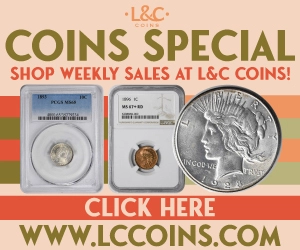By Al Doyle for CoinWeek …..
How does a person move from being a bullion investor to a collector? It’s not an either/or choice, as both options can be pursued simultaneously.
Genuine concern about the dollar’s declining value is what typically motivates investors to purchase gold and silver. The beaming luster, various designs, and the “cool” factor of precious metals will usually entice the buyer to inspect his purchase. The more he looks, the closer he gets to joining the collector ranks.
Noticing the Different Features on Bullion Coins is the First Step to Collecting
It may take a little while before the newbie notices the different dates on American Silver Eagles or 90 percent silver coins. If he or she has even a drop of curiosity, the investor starts to wonder what else may be available in coins. Investigating other precious metals options only takes a few mouse clicks today. The guy who owns some Eagles soon discovers Canadian Maple Leaves, Philharmonics, Krugerrands, Mexican gold pesos and silver Libertads, Australian Kangaroos, Chinese gold Pandas, and other options.
Since bullion buyers tend to be interested in history, it isn’t a massive leap to exploring older and different coinage. Once a person has obtained an assortment of more recent products, older gold and silver is the next logical step. When it comes to gold, it’s a short detour to pre-1933 $20s, $10s, and $5s, as those coins often sell for prices that aren’t a great deal more than 21st-century rounds and bars.
Beyond Bullion – Circulating Gold Coins from the 19th and Early 20th Century
With some searching and patience, a gold bug can assemble a collection featuring dozens of different dates from the $5 Liberty and Indian Head, $10 Liberty Head, and the $20 Liberty and Saint-Gaudens series without paying much more than bullion value. If money is tight, fractional world gold such as the French, Swiss, and Belgian 20 franc, British Sovereign, Dutch 10 guilder, various Austrian coronas and florins, Russian rubles, and pieces from Peru, Argentina, Colombia, Denmark, and Sweden are available at modest premiums above spot.
Moving from pure investor to the investor/collector hybrid is for more than just the gold crowd. Even low-budget silver shoppers can diversify for very little cash. The local coin shop’s bucket of 90 percent often includes some Mercury dimes and Walking Liberty half dollars. I have seen more than a few well-worn Standing Liberty and Barber quarters, some stray 1892 and 1893 Columbian Exposition half dollars and a Booker T. Washington half dollar or two in piles of “junk silver.”
Many Collectors Develop a Soft Spot for Circulating Silver Coins
The most interesting low-cost bullion diversions are the hundreds of world silver coins that gather dust at American coin shops. Assembling an extensive collection without ever spending more than $15 on a coin is a real possibility. The more likely silver numismatic option is climbing higher on the price scale to pursue circulated and Mint State Morgan and Peace dollars along with well-known series such as Mercury dimes, pre-1965 Washington quarters, and Franklin half dollars. Recent silver Proofs (especially 50 State quarters) and commemoratives are another option for the silver enthusiast who wants affordable variety.
Collectors Seek Value Beyond Bullion
Becoming a numismatist at some level instead of a pure bullion investor means a person will eventually obtain coins with a higher degree of collector value than intrinsic value. It’s not a problem once the hard-money person grasps and understands the appeal of older, historic coinage.
* * *

I consider myself mostly a collector but with low silver prices I have lately been focused on bullion coins and 90% silver. Combining the two interests, I have almost completed a date collection of bullion Silver Eagles and examples of most of the world bullion coins. Also I bought $3 Whitman folders and have been putting together date/mintmark sets from junk silver bins including Roosevelt dimes, Washington quarters, Franklin Halves and all 3 are almost complete. I also have been working on Mercury dimes, Standing Liberty quarters, and Walking Liberty Halves. These are much more challenging to put together a set but makes silver stacking much more fun and exciting. I have been surprised at how many low mintage coins I have found putting these sets together.